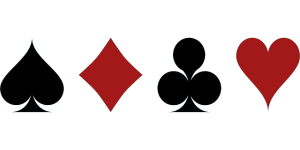You’ve got to know when to hold ’em,
know when to fold ’em;
know when to walk away,
know when to run...
So goes the gambler’s advice to the young card player in the hit Kenny Rogers song.
Hum along as we think about how we play our cards when we’re in debt: do you file bankruptcy or not. The hardest call is to know when to fold and file for bankruptcy.
Do you play a bad hand
With few exceptions, everyone wants to repay the debts they consider legitimate.
- Paying your debts fits our self image and our values. We make heroes of people who’ve scrimped, worked two jobs, gone without, to pay their debts in full.
- Congress in 2005 made much of taking “personal responsibility” for your debts. The pro-creditor Congressmen cast bankruptcy as the choice of those unwilling to shoulder the consequences of their actions.
- Those peddling credit shout that bankruptcy will cripple you in the credit market til the end of time.
If you’re in debt, it’s hard to know how sort your choices and to know which to discard and which to hold on to.
What no one talks about
No one talks about the big-picture cost of paying off debt.
No one talks about those whose bull-headed commitment to payment blinded them to other needs and other financial threats.
No one talks about those who sacrifice for years and still can’t pay their way out of debt.
No one talks about debt-ridden elders with no hope of better times ahead.
Weighing the bankruptcy factors
So, how do you assess your cards, so to speak, when choosing between get-out-of-debt strategies?
Just like playing cards, the decision to commit to paying off your debts depends on the relationships between the cards you hold. It’s the relationship between the factors that are important, not hard and fast rules. Let’s look at the factors.
How much do you owe?
HOLD: the smaller your total debt, the more likely you can pay it off.
FOLD: the larger the total debt, the longer it will take and therefore the more likely other events interfere.
How old are you?
HOLD: the younger you are, the longer your remaining working life and your chances to catch up on other needs when debts are paid off.
FOLD: the closer you are to retirement, the less likely it’s smart to continue struggling with debts.
Do you owe taxes, support, or mortgage arrears?
HOLD: if these critical kinds of debts form no significant part of your debt, a payment plan for other debts is OK
FOLD: paying unsecured bills when you owe taxes, back family support or are behind on house payments is risky
How well are you fixed for retirement?
HOLD: try to pay your debts if you have a solid pension or substantial retirement savings
FOLD: if you are behind on saving for old age, your money is better spent on retirement than old debts
Do you have any reserves for emergencies or job loss?
HOLD: if you have money available for the unexpected or the temporary loss of income, try to pay off debt
FOLD: with no reserves, you make yourself even more vulnerable diverting money to existing debt
Avoid the biggest loss
What you want to avoid is throwing money after old debt in a campaign that can’t succeed, or that risks even more than your pride if you don’t make.
To live paycheck to paycheck, and starve your savings trying to do the impossible is not smart. And it’s not necessary.
Kenny Rogers’ gambler told him:
That the secret to survivin’
Is knowin’ what to throw away
And knowin’ what to keep
Keep paying on old debts only if you hold the cards to succeed. Otherwise, fold ’em, file bankruptcy, and draw some new cards for a fresh start.
More
The biggest bankruptcy mistake
What is life after bankruptcy really like?







